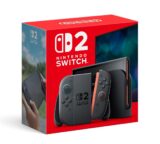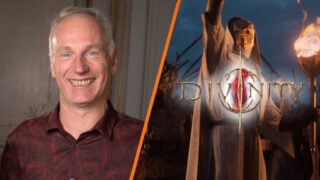Celebrating 30 years of #StarFox with the biggest cake we could find and a throwback photoshoot with our team that developed Star Fox Command and Star Fox 64 3D! pic.twitter.com/drEHfsS296
— Q-Games 🐤 All You Need is Help 🐷 (@PixelJunkNews) February 21, 2023
Q-Games’ Dylan Cuthbert on Star Fox, preservation and big PAL borders
Japan-based, London-born games boss discusses what next for Kyoto’s iconic indie studio

If we were ever unsure whether Dylan Cuthbert wanted to talk about Star Fox, one look at his attire would put such concerns to rest.
London-born Cuthbert, who previously worked at Argonaut in the 1990s and was a programmer on both Star Fox and the once-cancelled (but decades later, released) Star Fox 2, has seen his career continue way beyond Nintendo’s series.
Following a spell at Sony where, among other things, he developed the PS2’s famous ‘Ducks’ technical demo, in 2001 Cuthbert founded his own studio, Q-Games. 22 years later, he remains there as its president, and it’s in the sizeable meeting room of the Kyoto studio’s office where we now sit across from him.
Despite everything he’s achieved with Q-Games – including the critically acclaimed PixelJunk series and cult favourite The Tomorrow Children – Cuthbert is clearly still happy to wear his past on his sleeve. Quite literally, in this case, given the Star Fox t-shirt he has on.
It’s July, and VGC are in Kyoto to attend BitSummit, the Japanese indie festival Q-Games itself helped set up in the first place. While there, we’re invited to pay the studio a visit to play its most recent release (PixelJunk Scrappers Deluxe), its next one (the PS5 version of PixelJunk Eden 2) and other things not yet announced.
The upcoming port of PixelJunk Eden 2 on PlayStation consoles – it was initially a Switch exclusive – marks a homecoming of sorts for Eden. The initial wave of PixelJunk games (Eden included) were among the first critically acclaimed digital-only releases for the PS3, and many players pointed to them as a shining example of how smaller games could thrive with the advent of digital stores on consoles.
Cuthbert, again demonstrating his affinity for the past, explains to us that the PixelJunk series was inspired by the early days of video games, most notably the era of the ZX Spectrum home computer.

“One of the guys at Sony said: ‘Hey, we’ve got this PSN store thing coming out, and this means that small companies like Q-Games can actually release their games and be a self-publisher’,” Cuthbert recalls. “And that’s basically where the whole PixelJunk idea came from.
“So I went back, and PS3 was out, or had just come out, and it was the first ever console which had HDMI as a standard, and that’s where all the ideas really came from. It was like: ‘Oh, we can actually have pixel perfect graphics, no colour crawl’ – you remember, all the games used to have colour crawl back in those days – and what I did is, I went back to the old 8-bit games, the Spectrum games.
“And I just grabbed a whole ton of screenshots of old Spectrum games from the internet, and I tiled them on an HDMI screen at 1080p. So you’ve got those old 192 pixel-high screenshots, and suddenly you’ve got this crazy amount of resolution, and those Spectrum graphics all suddenly started looking really good at that resolution. I thought, ‘you know, this is actually quite interesting.’
“So that’s when we thought: ‘OK, let’s build a whole bunch of new games that pull on that aesthetic, that pixel-perfect kind of aesthetic, and the gameplay from those old games as well.’”
“PS3 was the first ever console which had HDMI as a standard, and that’s where all the ideas really came from. It was like: ‘Oh, we can actually have pixel perfect graphics, no colour crawl’”
Another thing Cuthbert liked about HDMI was that there was no longer a need for a tint control knob, something common on NTSC televisions and something he wasn’t made aware of until he travelled to Japan.
“In Europe we were okay because we had PAL, but everywhere else – I mean, Japan and the US had NTSC and it was terrible. You know the joke terminology for NTSC? It’s ‘Never The Same Colour’. It really never is, because you had that little knob with it to change the hue.
“When I came to Japan for the first time I was playing Mario or something, and all the yellow was red. I was like ‘what’s going on with this?’ and then there was a little knob on the front or the back of the TV and you had to tune it to match the colours. The other joke is, you know what PAL stands for? ‘Perfect At Last’.”
Of course, as we note, it’s not like PAL users had it any better. Europe may have had the edge with a higher resolution and more accurate colours, but the slower refresh rate meant games in the ‘80s and ‘90s regularly ran slower on PAL televisions.

“That was the balance, right?” he replies. “You could get either the right colours or the right speed. I remember playing Super Mario Bros 3 in the UK at 50Hz, it was very different to the 60Hz version.
“As for the borders, PAL had an extra 48 scan lines or something like that, so when all the games were made for NTSC they made them into their resolution format, then when they brought them to PAL they just kept the same resolution, and that’s why we had the borders. So you didn’t lose any pixels, you actually had more pixels, they just weren’t being used.”
Going back to the PlayStation link, we ask Cuthbert if he thinks a smaller developer would still be able to enjoy the same level of success Q-Games did with the PixelJunk games in the early PS3 days, especially given Sony’s lessening of its foothold in its homeland with the closure of its Japan Studio.
“I think so,” he replies, optimistically. “Because they’ve got this new sort of portfolio group, and the indie group, which has come to BitSummit, so I think there’s still a way for people to get in there. You’ve got games like Stray, which recently cropped up. I think it’s probably a bit easier now, actually, than it was a few years back.
“When I came to Japan for the first time, I was playing Mario or something, and all the yellow was red. I was like ‘what’s going on with this?’ and then there was a little knob on the back of the TV and you had to tune it”
“Maybe when Japan Studio existed, it might have actually been harder in a way because it was very corporate. The Japanese side of PlayStation didn’t really have anything for indie at all.
“They had a little bit way back in the PS3 days, games like Trash Panic and Echochrome. They had a few of those indie-style games back in the very early days of PS3 and then just didn’t do anything more. Especially moving into the PS4 era, they just kind of cut down a little bit on that side of things, I think.
“But now I think they’re building up again and the lack of Japan Studio probably helps that because it’s all globalised now. So you can actually approach it from anywhere and you can still then reach all the different markets even if you’re a newbie, which is great.”
The studio’s partnership with Sony hasn’t always gone as swimmingly as it had with the PixelJunk series. In October 2016, Sony published The Tomorrow Children, a collaborative online game developed by Q-Games with a unique minimalist look and Soviet-like art design.

Within just 10 months, Sony closed down The Tomorrow Children’s servers, terminating the online-only game entirely. Despite Sony rarely agreeing to sell its IPs, Cuthbert’s Q-Games acquired the IP and resurrected the game in 2022 as the appropriately named The Tomorrow Children: Phoenix Edition.
We ask Dylan if he’s perhaps someone who has trouble letting go of his games, given the rebirth of Tomorrow Children and the numerous PixelJunk ports over the years.
“Well, I think every game is a legacy, right?” he replies. “So it’s like a book or a movie. I wish the games industry was a bit more like that. So for example, you could go and watch Kubrick’s 2001: A Space Odyssey, and you don’t have to worry about someone having to remake it so you can watch it again – you can just go and watch it.
“And I think in the games industry, we’re still at a bit of an early stage for that legacy building side of things.”
Cuthbert shares with us his vision of an online archive where people can legally play any classic game via the cloud, no matter how obscure. In his eyes, the early days of video games are a goldmine of untapped one-off ideas.
“You could go and watch Kubrick’s 2001: A Space Odyssey, and you don’t have to worry about someone having to remake it so you can watch it again – you can just go and watch it.”
“With virtual systems and cloud technology there should be a way to just basically set up a place where, at least by emulation, all the stuff can be run,” he explains. “And they could even charge for it.
“It could be on a PlayStation service or anything, but somewhere that you can just go in and say, ‘I want to play the Spectrum version of Bugaboo the Flea, or the C64 version of Spy vs Spy’, and you just bring up the emulator and you just play it.
“We’ve got modern streaming technology. It would be great, because you’d just have everything there, including all the obscure games that were around. I mean, there were some really crazy ideas that are just fun to go in and explore – even if they weren’t quite finished as ideas, you still get some inspiration from all that.”
Such services exist to some degree – the most notable being retro streaming service Antstream Arcade – but so far Q-Games has yet to dip its toes into the water.
“Yeah, not yet,” Cuthbert replies. “But I think we’re looking to relaunch some old classic titles, and that’s for next year. So that’s one way of getting that sort of legacy back in.”

We ask if the closure of the PS3, PSP and DSiWare stores – all of which included Q-Games titles, such as the brilliant Nintendo-published Digidrive (known as Intersect in Europe) – has inspired him to take more of an active role in preserving his games.
“Yeah, I think so,” he says. “I think the DSiWare is the [biggest loss] because those games are really good. They were some of the highest rated games on DSiWare but nobody got to play them because it was DSiWare and it wasn’t that popular.
“And so at some point, I’m hoping – I’m just got my fingers crossed because unfortunately it’s not our IP so we can’t actually do anything with it, but they’re all our original ideas – I hope that Nintendo at some point works out a way to get all those DSiWare titles onto some sort of emulated system, or release them all on Switch, like a pack or something, like they did for Star Fox 2.”
Now that he’s mentioned it, it would be rude of us not to. Star Fox 2 was an all but complete SNES sequel that Nintendo decided to scrap in favour of directing its focus on the upcoming Star Fox 64. Although the near-finished version found its way online over the years, it wasn’t until 2017 that Nintendo officially released it for the first time as one of the games on the SNES Mini. It can now be played on Switch Online’s SNES library too.
“I think the DSiWare is the [biggest loss] because those games are really good. They were some of the highest rated games on DSiWare but nobody got to play them because it was DSiWare and it wasn’t that popular.”
We ask Cuthbert if he was frustrated to see something he’d worked on for so long being scrapped at the time. “Yeah, but there’s so many games – I mean, not so much Star Fox 2 because obviously it’s a bigger title and people noticed it more – but there are so many games that didn’t get released and just disappeared, especially in the ‘90s,” he points out.
“And each one had some reason why it just didn’t come out, or maybe three months from the end they ran out of money and the company went under, or something that – there’s loads of that stuff in the history of the games industry that you’ll probably never see ever again.”
He notes that he had no idea the game was set to be officially released in 2017, saying “that was great”. We tell him we’re surprised he wasn’t told in advance.
“Well, why would they – I mean, I was an employee of Argonaut Software back in the day, and they developed the emulated version internally I think, so there was no real reason for them to reach out.

“We weren’t doing any Nintendo work at the time, so there was no way to even get the gossip, I suppose, on that one. Nintendo’s very close-lipped, very tight-lipped, they keep the lid on everything, so even if they wanted to, they couldn’t say it.”
Before continuing with our Star Fox-themed line of questioning, we make doubly sure Cuthbert isn’t bored of talking about the series.
“Well, I’ve got the t-shirt on,” he laughs. We’d noticed.
“I think it’s still a pretty original title really, isn’t it? There isn’t really an equivalent game to Star Fox even now, so I think that’s why it’s kind of stuck around and kept in people’s minds. It’s weird, but it’s remained a fairly unique title and I think that’s really cool.
But I’m not bored of Star Fox, really. It was a fun project, it was fun to make, I was very young at the time but it was just a really good experience all around. Just one year of development time, everything packed in there, and there was only really a handful of us working on it.”
We wonder if he expects to see the series make a comeback one day. “Oh, I’m sure,” he replies, though he’s unsure if it will be able to match the feeling of the SNES original.
“I mean, they keep trying, don’t they? They keep trying, not quite achieving the original.
“But I think that’s one thing – my opinion is that the original was born out of the UK Amiga-style 3D at the time, games like Star Glider or Carrier Command. It was born out of those and a bit of the Star Wars Arcade game, combined with Namco’s Starblade. And then there was all the Nintendo character building, all the characters and stuff, making it very family friendly.
“It’s the combination of all those things that I suppose was what made Star Fox what it was. So some of the more recent titles – maybe, say, the Namco version, for example – are all great games, but there’s always that one element missing, that sort of UK old-school 3D shooting game element missing from it.
“So that one was very slick – they got the Starblade side of it perfect, but it’s a combination of all those things, you kind of need it all in there to make it work.
“And then, of course, the one that Rare made, Star Fox Adventures, that was also a good attempt but that was too British, it didn’t have the Starblade side of it.
“So I think Star Fox is a very complex title, because you’ve got to have all those elements in place, and that gives it the atmosphere it needs to make it really work.”















